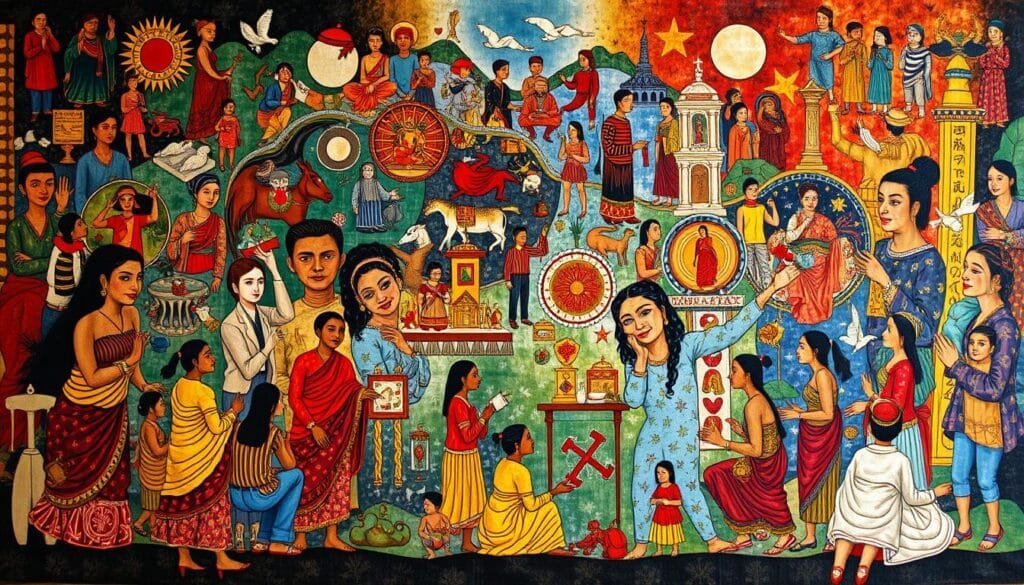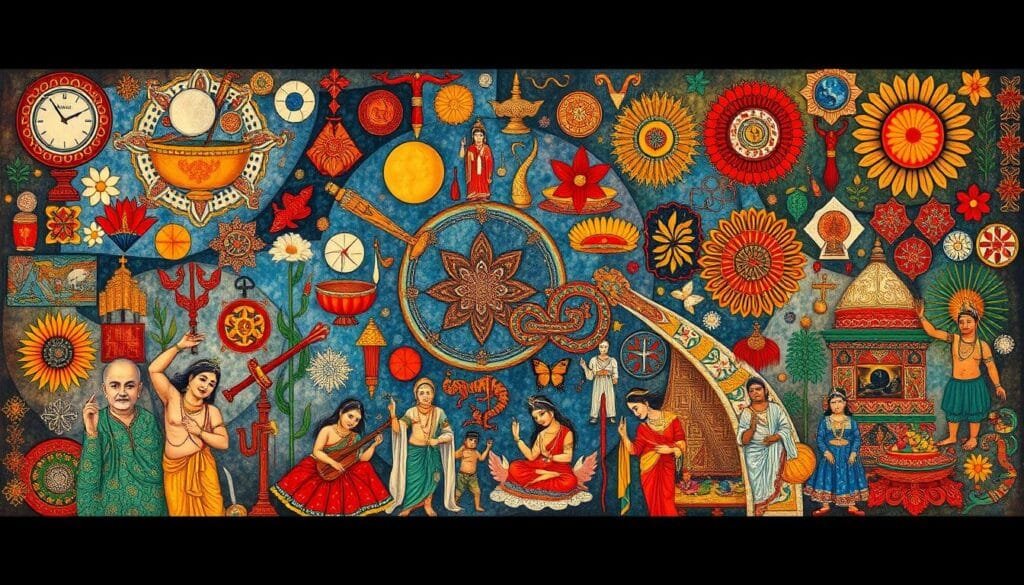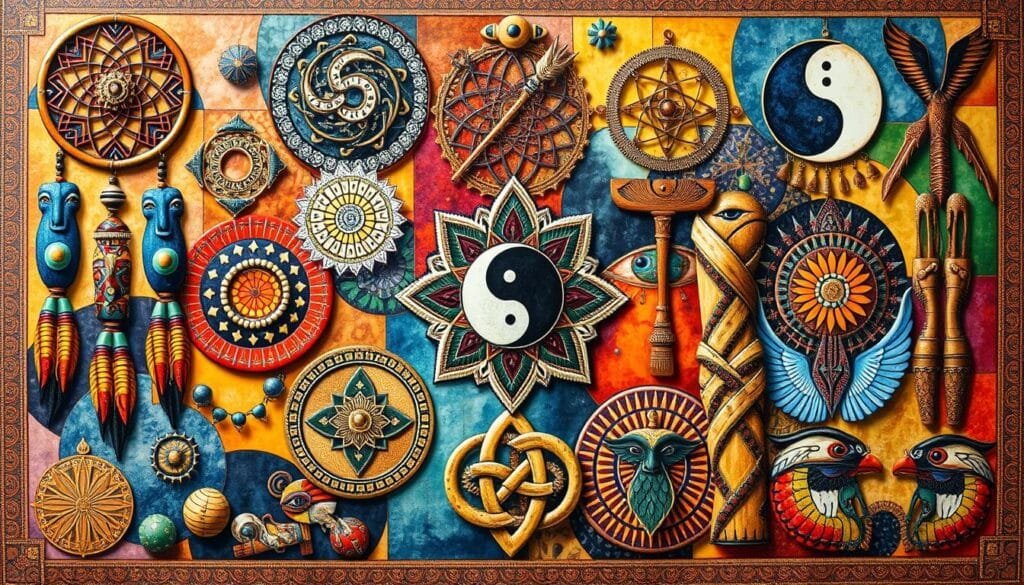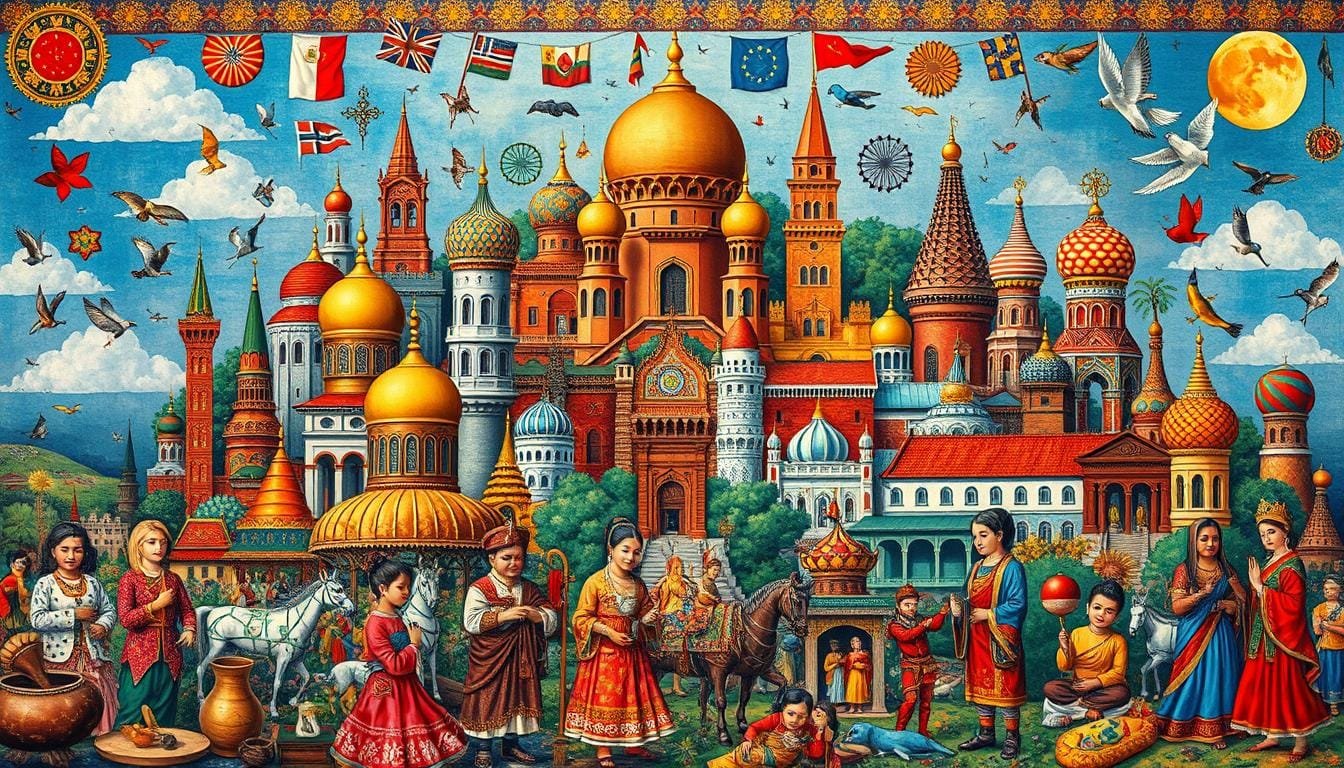Have you ever thought about how culture affects who we are and how we act every day? Knowing about culture helps us connect better in our diverse world. We learn about the beliefs and customs that shape various groups and how we see our surroundings.
Culture always changes with our personal stories and society’s shifts. Consider how 20% of meals in America are eaten in cars, showing a slice of our culture. Small talk about weather and sports happens a lot too. More than 100 million watched the 2017 Super Bowl, showing football’s big role in the U.S.
Our actions, thoughts, and feelings reflect our cultural backgrounds. Our cultural identity guides our choices, forms our values, and connects us with others. Dining out and celebrating holidays like Thanksgiving bring us together, giving us a sense of community.
It’s vital to understand and value different cultures for a better society. This knowledge lets us appreciate the beauty of diversity. By learning about other cultures, we can form fairer and more open relationships. For deeper insight on culture’s link to communication, check out this detailed exploration.
Key Takeaways
- Culture shapes our identity, decisions, and interactions.
- Understanding cultural diversity is essential for fostering meaningful connections.
- Daily activities, such as dining habits, reflect cultural norms.
- Major events like the Super Bowl highlight cultural significance.
- Cultural awareness promotes inclusion and appreciation of different backgrounds.
Understanding Cultural Rituals and Their Impact
Cultural rituals help shape society. They range from daily habits to big life events. Rituals keep traditions alive and strengthen community ties.
They give us a sense of belonging and identity. They link us to our community with shared experiences and histories.
Daily and Weekly Rituals
Our daily routines, like a morning coffee or family dinners, are key rituals. They make life feel normal, boosting well-being and connecting us. These small rituals matter, especially in our diverse world with thousands of languages and hundreds of countries.
Annual and Lifetime Rituals
Big celebrations or personal events like weddings are important rituals. They create a sense of unity and identity. Studies show these rituals can make us less anxious or depressed.
They also help pass down culture through stories, building strong community values.
Connecting Through Shared Experiences
Being part of community events or group prayers brings people together. These rituals have a huge social impact. They spur innovation and improve teamwork.
When we learn about our cultures, it makes us more open. Communities that embrace diversity see less discrimination.
Learning about cultural rituals helps us appreciate different societies. It makes our social connections stronger and more meaningful.
The Role of Norms in Shaping Behavior
In our society, social norms are key. They serve as the unwritten rules that shape how we act. These can be formal, like laws, or informal, such as manners. Both kinds guide our community interactions.

Understanding these norms helps us see how culture influences behavior. They set the behavior we expect in different situations. For example, 70% of people follow dress codes at work, showing how culture affects what we wear.
Here are some behaviors influenced by social norms:
- Almost 90% cover their mouths when they cough, showing a norm of hygiene.
- About 75% think being on time is important, showing we value punctuality.
- In Eastern Asia, over 60% use chopsticks, which is a dining norm.
Social norms also shape our economic decisions. Norms against women working can lower labor force and skills. Yet, cultures that value starting businesses can boost entrepreneurship, helped by mentors.
Rituals like greetings differ due to these norms. In the West, half the people shake hands. In Japan, bowing is common. These examples show how norms vary between cultures.
The idea of personal space shows more about cultural expectations. Westerners keep a space of 1.5 to 2 feet in talks, respecting privacy. It shows the role of cultural norms in our actions.
Realizing the strong role of social norms helps us understand behavior within different cultures. It reveals the implicit and explicit standards we follow.
How Values Reflect Our Cultural Identity
Values are important beliefs that guide how we act within our culture. They help shape who we are and show the beliefs of different societies. Both old and new values play a big role in cultural identity and how societies change over time.

Schwartz and Bilsky identified ten main value types: benevolence, universalism, security, tradition, conformity, power, achievement, self-direction, hedonism, and stimulation. These values show up differently in traditional and modern views. They influence how we view ourselves and interact with others.
Traditional Values
Traditional values focus on community, family, and group well-being. In Eastern cultures, values like humility, respect, and security are important. These values put the group before the individual, creating a strong shared identity.
Western cultures value power, achievement, and the pursuit of success more. Even with these differences, traditional values help keep society orderly and connected. They show what’s important to a community.
Modern Values
Modern values lean toward new ideas, individual rights, and personal freedom. They make personal goals, creativity, and success very important. Studies show that in Western cultures, 80% of people focus on their own achievements.
In cultures that value the group, 70% still see shared goals as crucial. This mix of new and old values changes cultural identities and affects society’s values deeply.
| Culture | Traditional Values | Modern Values |
|---|---|---|
| Western | Power, Achievement, Pleasure | Individualism, Personal Freedom |
| Eastern | Humility, Respect, Conformity | Innovation, Personal Success |
It’s important to understand both old and new values to appreciate a culture’s ethics. Recognizing this variety helps highlight the role of cultural identity. It shapes how societies behave and what they expect.
The Importance of Symbols in Culture
Symbols are a key part of our culture. They show our identities and values without words. Cultural symbols like national flags and the peace sign share deep meanings. They connect us to our past and what we aspire to be.

Take the Kente stole, woven for royalty and special occasions. Each color and pattern has a meaning. For example, black stands for growing up and spirituality. Gold reflects royalty and wealth. These symbols show important values and beliefs of a culture.
Understanding these symbols gives us insights into a culture’s deeper meanings. The Adinkra symbols in Kente express cultural philosophies. “Gye Nyame” signifies God’s power. These symbols bring people together, across time and different cultures. They strengthen our collective identity.
Symbols also help preserve our culture and heritage. They share messages of resilience, success, and richness. Wearing something like a Kente stole, or showing a national flag, lets us honor our roots and what we share with others. It makes our personal and shared stories richer.
Let’s look at what the colors on a Kente stole mean:
| Color | Symbolic Meaning |
|---|---|
| Black | Maturation and spirituality |
| Gold | Royalty and wealth |
| Green | Vegetation and fertility |
| Blue | Peace and harmony |
The meanings of these colors and patterns are important. They connect us emotionally and intellectually. They show how symbolism is vital in understanding ourselves and others across cultures.
Exploring What Culture Means in Different Societies
Looking at how culture changes from place to place gives us a deep insight into human variety and the complexity of society. Every society’s traditions show both how they differ and what they share, because of their unique surroundings and pasts. By understanding these cultural details, we do more than just expand our views. We also see the big role culture plays in our everyday lives.
Comparative Analysis
Different cultures keep their identity and customs in interesting ways. Take the Konyak Tribe in Nagaland, India — they focus on gender equality, making sure everyone gets the same chances for learning and jobs. On the other side, the Kalash people in Pakistan hold onto unique religious beliefs from ancient times, despite being in a mostly Islamic area. These examples show us how culture influences how societies work and how people behave.
Impacts on Daily Life
Daily life among native groups shows special cultural traditions. For instance, the Black Hmong in Vietnam practice eco-friendly farming, growing rice on terraces to help the environment and their community. And in Kenya, the Maasai use a mix of red ochre and animal fat on their skin to protect it from the sun. These traditions are key to how societies impact the environment and daily life.
Role of Language and Artifacts
Language and artifacts play big roles in understanding culture. Between 20,000 and 30,000 people speak the Sami language in parts of Norway, Sweden, Finland, and Russia. They’re working on bringing their language back through schooling in both their language and the country’s. Also, places like Taos Pueblo in the USA and Ksar Ait Ben Haddou in Morocco, both UNESCO World Heritage Sites, let us see and feel unique traditions and architectural heritage. They link us to history and show the importance of keeping cultural heritage alive today.
Below is a comparative table highlighting some societal practices across different cultures:
| Culture | Unique Practice | Societal Impact |
|---|---|---|
| Konyak Tribe (India) | Gender Equality Promotion | Equal Opportunities in Education and Work |
| Kalash People (Pakistan) | Distinct Religious Beliefs | Cultural Coexistence amidst Predominantly Islamic Region |
| Black Hmong (Vietnam) | Sustainable Agriculture | Environmental Protection and Community Livelihood |
| Maasai (Kenya) | Traditional Sun Protection Methods | Daily Life and Health |
| Sami People | Reindeer Herding and Language Revitalization | Food, Clothing, Transportation, and Cultural Preservation |
| Australia | Multicultural Landscape | Enriched Cultural Diversity and Societal Harmony |
Conclusion
Understanding culture is key to appreciating human societies’ diversity and complexity. In this article, we’ve explored the role of rituals, norms, values, and symbols. They shape our lives and help us understand society. They also bring people together globally.
Cultural appreciation means recognizing and embracing our differences. It shows how these differences are part of the larger human experience.
We’ve looked into cultural competence, which is vital for communicating across cultures. We talked about the importance of staying humble and always learning. This was first talked about in 1998.
By welcoming many views, like the gracious space concept in 2018, we create a safe and open environment. This is important in healthcare, where knowing a patient’s culture is critical.
Today, digital media and personal creativity are booming through blogging and MP3s. This shows how technology has changed the way we express ourselves. Small communities are growing, and cities are becoming more vibrant culturally. This change blurs the line between cultural creators and consumers. It highlights the importance of creative networks.
As we advance, we must keep cultural appreciation and understanding as our main goals. This will help us unite globally. By doing this, we make our own lives richer and improve the world we share.
FAQ
What is cultural identity?
Cultural identity is about the beliefs, practices, norms, and values shared by a group. It shapes who we are, drives our choices, and influences our view of the world. It also affects our interactions with others.
How does culture impact society?
Culture shapes our identity and influences our decisions. It affects how we see the world and interact with others. Culture is key in connecting people from different backgrounds within a diverse society.
What are cultural rituals?
Cultural rituals are meaningful practices done regularly by a group. These rituals can be daily, weekly, or for special events in life. They keep traditions alive and strengthen bonds within the community.
How do daily and weekly rituals affect our lives?
Daily and weekly rituals give us routine and a sense of belonging. They connect us to our community and culture, building strong social ties.
What are some examples of annual and lifetime rituals?
Annual and lifetime rituals include events like Independence Day, religious celebrations, weddings, and funerals. These events maintain our traditions and bring us closer to others in our community.
Why are shared experiences important in a culture?
Shared experiences create a sense of belonging and identity. They connect us to our community, helping us understand and appreciate common values and history.
What are social norms?
Social norms are rules for how to behave that everyone in a culture follows. These can be official rules or unwritten ones. They help us know what’s expected in social situations.
How do norms influence individual behavior?
Norms guide our actions within a community. They shape how we interact and how society functions. Understanding them is important in cultural settings.
What are cultural values?
Cultural values are the important ideas that guide our actions and decisions. They include both old and new ideas that shape our cultural identity and how society changes.
What are traditional values?
Traditional values focus on the community, family, and the good of everyone. These values come from long-standing beliefs and practices that continue to influence culture today.
How do modern values differ from traditional values?
Modern values prioritize new ideas, individual goals, and freedom. They differ from traditional values, which focus more on the community. This difference influences how societies grow and change.
Why are cultural symbols important?
Cultural symbols, like flags and icons, represent our identity and beliefs without words. They express important ideas and tell the story of a society’s history and goals.
How do symbols reflect national identity?
Symbols show our collective history, values, and dreams. They remind us of our shared culture and the principles that unite us.
What does exploring cultural diversity entail?
Exploring cultural diversity means looking at how different groups express their own identities. It helps us understand and appreciate the variety in the world, bringing us closer together.
How does culture impact daily life in different societies?
Culture affects daily life through norms, rituals, and values that shape how we act and interact. It touches on everything from how we talk to what we eat and our social habits.
What is the role of language and artifacts in culture?
Language and artifacts hold deep cultural meanings. Language lets us communicate and share stories, while artifacts represent our history and social values. Both are crucial for cultural identity and daily life.
